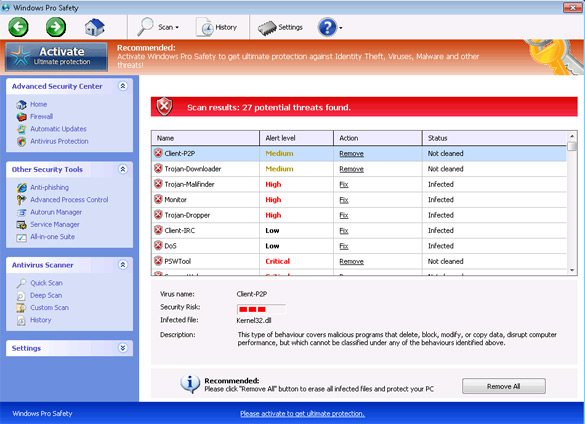Windows Pro Safety is an emerging threat classified by security experts as a rogue antispyware program. Such applications are known for their vicious nature in the way that they attempt to extract money from computer users by means of aggressive scams. The scam that Windows Pro Safety carries out is one where it pretends to be a legitimate antispyware or antimalware program for Windows PCs. This task usually involves displaying bogus alert messages along with returning system scan results populated with ridiculous threats.
Windows Pro Safety is among a long list of fake security programs for the PC. It is very difficult to remove especially since it does not allow uninstallation through the Windows control panel. This leaves many PC users out in the cold with attempting to remove Windows Pro Safety. Fortunately there is a way to easily and safely remove Windows Pro Safety. These methods may be used by novice or advanced PC users. No matter what, it is suggested that any user who runs into Windows Pro Safety take the necessary actions to remove it and never purchase the Windows Pro Safety program. Windows Pro Safety is an utter waste of time and money all created by cybercrooks.
How Can You Remove Windows Pro Safety?
Windows Pro Safety can be very difficult to manually remove if you are an inexperienced computer user. Not to mention, Windows Pro Safety has been known to populate the Windows Registry with many different entries and removing the wrong entries could render a PC damaged or useless. The use of a reputable antispyware or antivirus tool is recommended to safely remove Windows Pro Safety from your Windows computer.
To easily remove Windows Pro Safety, find the following process and end them in the task manager. After that is done, delete each related Windows Pro Safety file from your hard drive. In additional to locating the following processes, it is recommended that you delete the Windows Pro Safety registry entries listed below as well. It is also a good idea to uninstall the Windows Pro Safety application via your add/remove programs function found in the Windows Control Panel if your system recognizes Windows Pro Safety has an installed program.
Windows Pro Safety files (and folders) to remove:
- %CommonStartMenu%\Programs\Windows Pro Safety.lnk
- %Desktop%\Windows Pro Safety.lnk
- %AppData%\result.db
- %AppData%\Protector-[RANDOM 4 CHARACTERS].exe
- %AppData%\Protector-[RANDOM 3 CHARACTERS].exe
- %AppData%\NPSWF32.dll
Windows Pro Safety registry entries to remove:
- HKEY_CURRENT_USER\Software\Microsoft\Windows\CurrentVersion\Policies\System “DisableTaskMgr” = 0
- HKEY_LOCAL_MACHINE\SOFTWARE\Microsoft\Windows\CurrentVersion\policies\system “ConsentPromptBehaviorAdmin” = 0
- HKEY_CURRENT_USER\Software\Microsoft\Windows\CurrentVersion\Run “Inspector”
- HKEY_LOCAL_MACHINE\SOFTWARE\Microsoft\Windows NT\CurrentVersion\Image File Execution Options\belt.exe
- HKEY_LOCAL_MACHINE\SOFTWARE\Microsoft\Windows NT\CurrentVersion\Image File Execution Options\alertsvc.exe
- HKEY_LOCAL_MACHINE\SOFTWARE\Microsoft\Windows NT\CurrentVersion\Image File Execution Options\sms.exe
- HKEY_CURRENT_USER\Software\Microsoft\Windows\CurrentVersion\Policies\System “DisableRegistryTools” = 0
- HKEY_LOCAL_MACHINE\SOFTWARE\Microsoft\Windows\CurrentVersion\policies\system “ConsentPromptBehaviorUser” = 0
- HKEY_CURRENT_USER\Software\ASProtect
- HKEY_CURRENT_USER\Software\Microsoft\Windows\CurrentVersion\Settings “net” = “2012-5-20_4″
- HKEY_LOCAL_MACHINE\SOFTWARE\Microsoft\Windows NT\CurrentVersion\Image File Execution Options\portmonitor.exe
- HKEY_LOCAL_MACHINE\SOFTWARE\Microsoft\Windows NT\CurrentVersion\Image File Execution Options\fsgk32.exe
- HKEY_CURRENT_USER\Software\Microsoft\Windows\CurrentVersion\Policies\System “DisableRegedit” = 0
- HKEY_CURRENT_USER\Software\Microsoft\Windows\CurrentVersion\Internet Settings “WarnOnHTTPSToHTTPRedirect” = 0
- HKEY_LOCAL_MACHINE\SOFTWARE\Microsoft\Windows\CurrentVersion\policies\system “EnableLUA” = 0
- HKEY_CURRENT_USER\Software\Microsoft\Windows\CurrentVersion\Settings “UID” = “rohjjdbsbt”
- HKEY_LOCAL_MACHINE\SOFTWARE\Microsoft\Windows NT\CurrentVersion\Image File Execution Options\vpc32.exe
- HKEY_LOCAL_MACHINE\SOFTWARE\Microsoft\Windows NT\CurrentVersion\Image File Execution Options\mrt.exe
- HKEY_LOCAL_MACHINE\SOFTWARE\Microsoft\Windows NT\CurrentVersion\Image File Execution Options\wnt.exe





